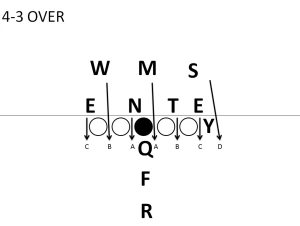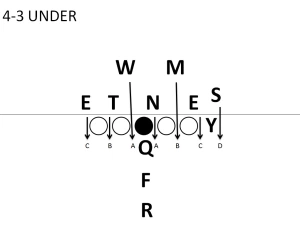Butch Jones got his new defensive coordinator. Just three days after defensive coordinator John Jancek was let go, Jones announced the hiring of Penn State defensive coordinator Bob Shoop. There is no doubt that Shoop was Jones’ number one target in this coaching search. Jones and Vol fans alike have a lot to be excited about. Shoop brings with him an exciting, aggressive approach that has been very successful at Penn State and in the SEC at Vanderbilt.
PHILOSOPHY
Who could explain Shoop’s philosophy better than Coach Shoop himself? When hired at Penn State, he said, “Our identity is an in your face style of defense that’s going to be fun to watch and even more fun for our players to play, I promise you that. It is based on two premises; relentless pursuit and never ending pressure. First thing I say to the guys all the time is `everyone has a game plan until they get punched in the face.’ We throw the first punch and we make sure it’s not the last punch and we keep on punching. That’s who we are.”
This should get Vol fans excited. Shoop does not want the offense to dictate the flow of the game. Instead, he wants to attack early and set the tone. He wants athletic players who play with aggressiveness.
Shoop has been remarkably successful with this approach. Over the past five years, Shoop’s units have finished in the top 25 nationally in total defense. This is remarkable considering that Penn State is just now returning to full scholarship allotments because of NCAA sanctions and Vanderbilt traditionally has the last talented roster in the SEC.
Shoop now enters Knoxville with a roster stocked with talent and poised for improvement. With as many as eight starters returning, Shoop will have more talent to work with than ever before.
FORMATIONS
Just like Jancek, Shoop also bases out of a 4-3 front. From a formation standpoint, the big difference between the two coaches comes with the use of the nickel package.
Jancek kept the Vols in a 4-2-5 nickel versus any offensive sets with three or more receivers. The Vols would only go to a 4-3 versus “pro-style” personnel groupings with two or less receivers on the field. In this era of the spread offense, that meant that, in 2015, nickelback Malik Foreman saw as many snaps as a regular starter and “starting” strongside linebacker Kenny Bynum struggled to find playing time.
At Penn State, Shoop preferred to play a base 4-3 on early downs, even if the offense had three receivers on the field. Shoop would bump his third linebacker, called the star, out to line up over the slot receiver. Shoop describes his star position as a “combination linebacker/strong safety.” This player must be athletic enough to play on the perimeter and in the open field, while big enough to move inside into the box.
To give you some idea of the size Shoop is looking for at this spot, Karl Butler played the star spot in 2013 at Vanderbilt at 218 lbs., while Brandon Bell, the star at Penn State last season, weighed in at 230 lbs.
Shoop prefers this approach because it allows him to get more size on the field for running downs. In a scheme that is predominantly based on zone coverage, Shoop can afford to give up some speed at the star spot because this player will rarely be asked to track a receiver in man coverage.
On passing downs, Shoop will take his star off the field and put in a cornerback to play the nickel spot. This is the same 4-3 look, but with a third corner on the field instead of a third linebacker.
Shoop’s base front is the 4-3 Over. This is what most people think of when they think of the 4-3. All three linebackers will line up stacked off of the line of scrimmage, while the four defensive linemen align on the line of scrimmage. The Vols will align in this front most of the time.
The defensive tackle, known as the under tackle, will line up as the strongside 3-technique, on the outside shoulder of the offensive guard. The nose tackle aligns as the weakside 1 technique, on the guard’s inside shoulder.

Shoop will use this base 4-3 Over formation versus two back, pro-style sets, and also versus three wide spread formations.
Shoop’s nickel formation will look very similar to the Over front, with the star simply being replaced by an extra corner.
Versus some pro-style sets, Shoop will shift into a 4-3 Under look. Here, the star linebacker will move up on the line of scrimmage and align outside the tight end. The two defensive tackles will flip sides. The nose tackle will align as the 1-tech to the strongside, while the under tackle lines up as the 3-tech to the weakside.

1 GAP DEFENSE
From a scheme standpoint, there are a lot of similarities between Shoop and Jancek. One of those is the preferred way to play defense at the line of scrimmage. Shoop coaches an aggressive 1 gap defense. Last offseason, we examined Jancek’s defense. Here is a quick refresher on what the 1 gapping principles look like.
“Typically, defenses are categorized as a 4-3 or 3-4, but that does not tell you how a team is defending the run. They key is what technique the defenders are playing with: 1 gap or 2 gap. In a 1 gap scheme, front 7 defenders are each responsible for one “gap.” They are aggressive players whose job is to attack their gap. A 1 gap scheme requires fast, athletic defenders. Typically, 1 gap teams play a 4-3, but some 3-4 teams, most notably those coached by long time NFL coach Wade Phillips, 1 gap.
A 2 gap scheme has the defensive linemen attacking offensive linemen. Their job is to control the blocker and demand a double team. This leaves room for the linebackers to roam free and make plays. This scheme calls for bigger, stronger linemen who can take on blocks and playmaking linebackers. Typically, 3-4 defenses are 2 gap defenses.
So what is Tennessee? The Volunteers, under John Jancek, are an attacking 4-3, 1 gap defense. Because of the attacking nature of the defense, the Vols love fast, athletic defenders…This is the beauty of the 4-3, 1 gap defense. Athleticism and speed reigns supreme. The defense is simplified, making it easier for players to make plays. Defenders have one job. Attack your gap.”
This is how Shoop can ensure “relentless pursuit and never-ending pressure” from his front seven defenders. Each lineman and linebacker is tasked with dominating their one gap. This allows them to play fast. Speed and athleticism is at a premium.
PERSONNEL
Not much will change regarding personnel for the Vols, but there are some adjustments Shoop will want to make.
Up front, the Vols have a cast of defensive linemen who fit the scheme very well. All four players will be 1 gap penetrators. Shoop wants to utilize the speed and quickness of his linemen. Guys like Derek Barnett, Corey Vereen, Kyle Phillips, Kendal Vickers, and Shy Tuttle will be great fits, as they will use their athleticism to attack.
At linebacker, the Mike and Will spots will look a lot like they did last year. Shoop wants athletes who will quickly diagnose plays and fly to the football. Jalen Reeves-Maybin fits the scheme perfectly, and Darrin Kirkland Jr. has as much talent as any player on the team.
It will be interesting to see who wins the starting star position. Jancek preferred a bigger linebacker, almost like a hybrid defensive end, at the strongside linebacker spot in his system. Curt Maggitt, a defensive end, Kenny Bynum, and Austin Smith (who played a lot of defensive end late in the season – I fully expect him to be full time at end for spring ball) played that spot in 2015. Shoop wants a different kind of a hybrid. This spot will now go to a hybrid safety, rather than a hybrid end.
Cortez McDowell and Elliot Berry are both former safeties and should compete for the spot. Since moving to linebacker, McDowell has bulked up to 240 lbs. He was actually the heaviest linebacker on the team (besides Maggitt, who spent more time at end) in 2014, but still has the range to play outside. Quart’e Sapp is another undersized linebacker who fits what Shoop wants in the star from a size perspective.
At corner, Shoop prefers to flip his players from side to side based on where the ball is spotted. One corner will always align to the field, while the other will always line up to the boundary. (To help explain boundary vs. field: if the ball is on the left hash, the boundary will be to the left, the short side of the field, while the field is to the right, the wide side.)
The field corner is a pure cover corner. He must have the ability to play in space, but he also will often get more safety help.
The boundary corner is often the best cover player on the team. Typically, defenses will roll their safeties to the wide side of the field and leave the boundary corner isolated with a receiver. He must also be a force in the run game. Cam Sutton, if he comes back for his senior year, is clearly the Vols’ best coverage player, and he would be a natural fit for this spot.
Overall, there isn’t a huge distinction between these positions. A corner is a corner. However, there are some subtle differences and Shoop likes to separate the two positions.
At safety, the coverage schemes often call for the safety to be able to defend a slot receiver deep downfield. This means they must be athletic players who excel in coverage. The strong safety will typically be a better run support player, but overall these two positions are pretty similar.
There is a lot of pressure on the safeties in Shoop’s scheme. In the past he has coached the safeties himself, and expects his safeties to make a lot of reads on the field. They must be intelligent players because much of the coverage scheme revolves around their ability to make the right read and be in the correct spot.
CONCLUSION
If you read the article about Jancek’s defense last August, then a lot of what you read above isn’t new. And that is a good thing. A big reason Jones hired Shoop is because there is not going to be a complete scheme overhaul. The 4-3, 1 gap approach remains the same. The emphasis is still on utilizing speed and athleticism to attack the offense. Shoop will likely take some of what Tennessee has done recently and morph it with his own scheme. However, Shoop will do some things differently, and it is interesting to take a look at how he differs from Jancek.
This post looked at Shoop’s general defensive philosophy. The general focus was on the run game, with the base fronts and 1 gap principles. Next week, I will post another article that will take an in-depth look at Shoop’s coverage schemes and how he defends against the pass. Some of the more interesting aspects of Shoop’s defense revolve around his coverage schemes, so be sure to check back next week to read more. (UPDATE: That article has since been posted and you may read it by clicking the link here)
If you have not already, you can go to the top left of the page to sign up to receive email updates when new articles are released.

Good job.
LikeLike
Thanks for reading, Marc.
LikeLike
Awesome work…I will spread the word about your site..Its about to pay off for us die hard UT fans that have stayed loyal to a sub par team…..GBO 2016
LikeLike
Jake, I’m glad you enjoyed the article, and thanks for sharing it. This is certainly an exciting time for Tennessee football fans!
LikeLike
Great read though most over my head
LikeLike
Thanks for reading, Gerry.
LikeLike
I love these articles!
LikeLike
I love these articles! Thank you for sharing.
LikeLike
Glad you enjoy the articles, Neal.
LikeLike
Excellent article, really informative!!
LikeLike
Thanks for reading, Wes.
LikeLike
Great read!!! Nice Job love it!! Thanks !!!
LikeLike
Glad you enjoyed the article, Paul.
LikeLike
Thanks Seth for all your work that goes into these articles.
LikeLike
Thank you for reading, Jimmy.
LikeLike
Wish I had known of these articles before now, but hey now I know. Great way to help people understand in Laymen’s terms with not a lot of knowledge of the x’s and o’s of football techniques. Look forward to reading many more Mr. Price. Good luck on all your future endeavors.
LikeLike
Thank you for the kind words, Eric. Glad you found the site.
LikeLike
Very informative article. Really helps me understand the defensive concepts.
I did not see McKenzie mentioned in the article. Any particular reaaon?
LikeLike
Glad you enjoyed the article, Steve.
McKenzie is not your traditional 1 gap defensive tackle. Typically, you see more guys with the size of Shy Tuttle at 311 lbs. in this scheme, rather than McKenzie at 344 lbs.
With that being said, he’ll be just fine. For his size, McKenzie is an athletic player, and sometimes a player is just so good that he doesn’t have to fit the scheme perfectly. McKenzie is that guy. He is a powerful force and will demand a double team. His improvement from game one to game thirteen last season was great and he should continue to improve. He is more than capable of playing and succeeding in the 1 gap scheme.
LikeLike